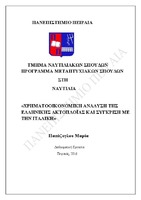Χρηματοοικονομική ανάλυση της ελληνικής ακτοπλοΐας και σύγκριση με την ιταλική

Προβολή/
Λέξεις κλειδιά
Ναυτιλία ; Ακτοπλοΐα ; Καμποτάζ ; Ελλάδα ; Ακτοπλοϊκές εταιρείες ; Χρηματοοικονομική ανάλυση ; Ιταλία ; Ανταγωνιστικότητα ; SWOT analysisΠερίληψη
Η πορεία την Ακτοπλοΐας είναι ιδιαίτερα σημαντική για την Ελλάδα, καθώς διαθέτει μεγάλο αριθμό νησιών και η οικονομία της βασίζεται σε μεγάλο βαθμό στον τουρισμό που είναι άρρηκτα συνδεδεμένος με αυτή. Σε αντίθεση με τους υπόλοιπους τομείς της ναυτιλίας, η ακτοπλοΐα επηρεάζεται από την πορεία την εθνικής οικονομίας και από τις μεταβολές στα εισοδήματα των επιβατών.
Στην παρούσα διπλωματική εργασία παρουσιάζεται η Ελληνική Ακτοπλοΐα και συγκρίνεται με την Ιταλική Ακτοπλοΐα. Η Ελληνική μαζί με την Ιταλική ακτοπλοΐα κατέχουν το 35 % της Ευρωπαϊκής Ακτοπλοΐας. Δεδομένου ότι οι μεγαλύτερες ακτοπλοϊκές εταιρείες στην Ελλάδα δρομολογούν πλοία στις γραμμές της Αδριατικής, η Ιταλική ακτοπλοΐα αποτελεί έναν από τους κύριους ανταγωνιστές της στην περιοχή της Μεσογείου.
Η παρούσα μελέτη αναλύει τα ιδιαίτερα χαρακτηριστικά του κλάδου της Ελληνικής Ακτοπλοΐας και στη συνέχεια πραγματοποιείται ανάλυση των βασικότερων χρηματοοικονομικών δεικτών για τις τέσσερις μεγαλύτερες ακτοπλοϊκές εταιρείες της Ελλάδας για το χρονικό διάστημα 2010-2014. Οι εταιρείες που χρησιμοποιήθηκαν για την παρούσα ανάλυση είναι η Ανώνυμη Ναυτιλιακή Εταιρεία Κρήτης (ANEK LINES), η ΑΤΤΙCA A.E. ΣΥΜΜΕΤΟΧΩΝ ( ATTICA GROUP), η Μινωικές Γραμμές ΑΝΕ (MINOAN LINES) και η Hellenic Seaways. Η σύγκριση της Ελληνικής με την Ιταλική Ακτοπλοΐα βασίστηκε στα οικονομικά στοιχεία των εταιρειών για το έτος 2013. Οι ιταλικές εταιρείες που χρησιμοποιήθηκαν για τη σύγκριση είναι η MOBY LINES, η GRANDI NAVI VELOCI, η VISEMAR DI NAVIGAZIONE SRL και η GRIMALDI GROUP.
Πιο αναλυτικά, η παρούσα διπλωματική εργασία αποτελείται από δέκα κεφάλαια και το παράρτημα. Στο πρώτο κεφάλαιο, παρουσιάζεται ο ορισμός της ναυτιλίας και η οικονομική της σημασία. Στο δεύτερο κεφάλαιο, παρουσιάζεται η ιστορία και τα κυριότερα χαρακτηριστικά της Ελληνικής Ακτοπλοΐας, ενώ στο τρίτο κεφάλαιο παρουσιάζεται το θεσμικό πλαίσιο που την διέπει και όλες οι πρόσφατες αλλαγές. Στο τέταρτο κεφάλαιο, παραθέτονται οι ευκαιρίες, οι απειλές καθώς και οι δυνάμεις και οι αδυναμίες της Ελληνικής ακτοπλοΐας μέσα από την ανάλυση SWOT. Στο πέμπτο κεφάλαιο, παρουσιάζονται οι τέσσερις μεγαλύτερες ακτοπλοϊκές εταιρείες στην Ελλάδα, ενώ στο έκτο κεφάλαιο γίνεται αναφορά στην οικονομική κατάσταση του κλάδου για την πενταετία 2010-2014. Στο έβδομο κεφάλαιο, αναλύονται οι σημαντικότεροι χρηματοοικονομικοί δείκτες των τεσσάρων εταιρειών για το ίδιο χρονικό διάστημα. Στο όγδοο κεφάλαιο, γίνεται η ανάλυση της μήτρας SPACE και στο ένατο κεφάλαιο παρουσιάζονται οι τέσσερις ιταλικές ακτοπλοϊκές και στη συνέχεια γίνεται η σύγκριση με του κλάδου της ακτοπλοΐας των δύο χωρών. Τέλος στο κεφάλαιο δέκα, πραγματοποιούνται κάποιες προβλέψεις, συμπεράσματα και προτάσεις για την ελληνική ακτοπλοΐα.


